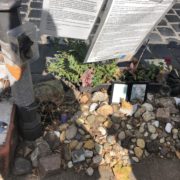Central Europe through a Cake Lens
By Cynthia Wang
Fourteen days is a long time to be constantly on the move, yet it is still somehow insufficient to process painful histories and their physical reminders.
Cake is a magnificent way to decompress. End your day with a selection of the local offering. Smother the horrors bouncing around the mind with sugar. Not only does it alleviate the stress of travel, but it also is a means for the mind to attach a series of activities chronologically to the passage of time.
Nothing exists in isolation. Cake itself is not of much interest to us, but it can be the lens that reveals important insights into experiences gained on the road. I will demonstrate this with an example from each of the four cities we visited.
1. Budapest: Somlói Galuska
 Our tour guide led us to the banks of the Danube. The Chain-Link Bridge groaned with the footsteps of a hundred thousand tourists. Old Buda watched us from its hilly perch. We listened to the guide explain the division of Buda and Pest, gazing distractedly across the river. Sixty pairs of iron shoes waited for us to lower our gaze to the embankment. They lay as though hastily abandoned, yet fixed as they were to the promenade, they are fated to wait eternally for their disappeared owners.
Our tour guide led us to the banks of the Danube. The Chain-Link Bridge groaned with the footsteps of a hundred thousand tourists. Old Buda watched us from its hilly perch. We listened to the guide explain the division of Buda and Pest, gazing distractedly across the river. Sixty pairs of iron shoes waited for us to lower our gaze to the embankment. They lay as though hastily abandoned, yet fixed as they were to the promenade, they are fated to wait eternally for their disappeared owners.
That evening I cut into a slice of Somloi Galuska, and watched a line of Hungarian Jews undo the laces of their shoes, laying them carefully on the ground. Hungarians shot into the river by other Hungarians is a narrative that screams for recognition. There were only so many different pairs of shoes, and then they repeat. Uniform, repeating, austere, the shoes reveals the inhumanity of victimhood, the invisibility of the dead. Faceless, lacking in variety, these representations of shoes are fitting- the death toll was so high that representations of actual victims are all our society seems to be able to bear.
Somloi Galuska is a sponge cake invented for the World Exhibition of 1958. This cake is accepted into the Hungarian’s collective construction of their national historic identity in a way the Hungarian Jewish narrative is not. In fact, the current Orbán administration is actively seeking to rewrite the complicity of the Hungarian state in World War II at the expense of Hungarian Jews.
I did not finish my Somloi. I left it, arranged in haphazard rows, to drown in a river of chocolate.
2. Vienna: Sachertorte
 Vienna is a strange city. Even the Viennese cannot decide if they are German or not. They welcomed the Anschluss when Hitler came knocking, in 1938, and yet they claim the singularity of being the first victims of his Nazis. Small wonder they turn their backs on the Turks, the Chinese, and the Somalians who come in moderate waves for jobs and security for their families. It is hard enough to determine one’s own identity, without the so-called Refugee Crisis wreaking havoc within Austria’s borders.
Vienna is a strange city. Even the Viennese cannot decide if they are German or not. They welcomed the Anschluss when Hitler came knocking, in 1938, and yet they claim the singularity of being the first victims of his Nazis. Small wonder they turn their backs on the Turks, the Chinese, and the Somalians who come in moderate waves for jobs and security for their families. It is hard enough to determine one’s own identity, without the so-called Refugee Crisis wreaking havoc within Austria’s borders.
“I say ‘so-called Refugee Crisis,’” Professor Rupnow said. “Because the term is extremely euro-centric. Europeans cannot conceive of their own racism, because to us, racism is the Holocaust and American slavery.” This sentence, baldly stated, become the subject over dessert.
“It’s so true,” Gabrielle said. “I’ve never heard anyone articulate that before. Sachertorte bïtte.” And the waitress glided off to the kitchen.
Sachertorte is perhaps the most Austrian dessert that exists. It was invented by a sixteen-year-old Franz Sacher for Prince Metternich. It even has its own day commemorating it; 5 December is National Sachertorte day. It was a beautiful thing- a tangible symbol of Austrian culture served by a Turk to a group of American students of immigrant heritage. And I reflected as we lifted laden forkfuls, that migration and globalization is a phenomenon that has, and will continue, to challenge the dominance of the nation-state’s borders. The four of us seated at that table were living proof of that, an affront to the creed of all the Freedom Parties and neo-fascist disciples of the world.
3. Bratislava: Medovnik
 We stopped at the Devín castle on our way out of Slovakia. The Devín castle is casually claimed by the Czechs, Germans, and Hungarians, in addition to the Slovaks. We heard about these conflicting claims to the rights of Devín as a place of memory. Professor Kilianova spoke to this, recounting the controversy she stirred up with her book legitimizing Devín’s other claims, to the consternation of the Slovaks.
We stopped at the Devín castle on our way out of Slovakia. The Devín castle is casually claimed by the Czechs, Germans, and Hungarians, in addition to the Slovaks. We heard about these conflicting claims to the rights of Devín as a place of memory. Professor Kilianova spoke to this, recounting the controversy she stirred up with her book legitimizing Devín’s other claims, to the consternation of the Slovaks.
Perhaps it is my naïveté that prevents me from accepting certain nationalistic premises, but I cannot help but find it silly that each side is so unwilling to share Devín Castle as a collective and inclusive lieu de mémoire. You all share a cuisine, why not a castle too?
Medovik, written also as “honey cake” in the menu I ordered from, is famed for its lengthy preparation time. It exists in the national gastronomy of every country who fights over Devín, and then some.
“Medovik? We have it in Belarus too,” Ivan said. Call me biased, but I think a cake is every bit as legitimate a vessel of national pride as a castle. However, where food unites, physical manifestations divide, and the walls of a stronghold does exactly that. A defensive structure designed to separate a state’s subjects from outsiders, Devín Castle will be the source of intercultural conflict as long as the idea of a nation-state holds sway.
4. Prague: Carrot Cake
 I saw the Lennon Wall for the first time when I was eighteen. I had come with such lovely ideas about Kundera’s homeland, the faceless communists who had squeezed him out, and the symbolic potential of a wall defaced daily in defiance of the regime. I had expected guards, some kind of illicit complicity between members of Prague’s finest underground champions of democracy. The Lennon Wall is barely remarkable. It is an artifact whose meaning is increasingly overshadowed by its brightly spray-painted surface. Where I expected to find clandestine meeting times and slogans, I found Greek letters and lopsided hearts around lovers’ names.
I saw the Lennon Wall for the first time when I was eighteen. I had come with such lovely ideas about Kundera’s homeland, the faceless communists who had squeezed him out, and the symbolic potential of a wall defaced daily in defiance of the regime. I had expected guards, some kind of illicit complicity between members of Prague’s finest underground champions of democracy. The Lennon Wall is barely remarkable. It is an artifact whose meaning is increasingly overshadowed by its brightly spray-painted surface. Where I expected to find clandestine meeting times and slogans, I found Greek letters and lopsided hearts around lovers’ names.
Two years later and this opinion solidified. My mother called me while we warmed ourselves in a café.
“What, you don’t like it?”
“It’s just kind of kitsch now,” I said. “I don’t think people look at it and remember what it’s supposed to mean.”
“What it means? You think you are remembering the old days better? What are you eating? Cake? We didn’t used to have the sugar for cake. Think about that,” my mother laughed.
I was indeed enjoying my customary slice of cake. This particular carrot cake was actually invented in the early 2000s by the owner of Cafetopia for tourists. A supposed vessel of Czech culture turns out to be a commercial reaction to tourism, years after the fall of Communism.
My mother keeps me humble. Raised in China, she bears testimony to the stark realities of life under Communist rule. My grandmother lived in the Soviet Union for a while. I have heard stories of the rigid rationing of sundries, and of course my criticism of the “dilution” of a pro-democracy and anti-war symbol is ridiculous to them. Who am I to criticize a bourgeois society as I eat a fake Czech cake and edit pictures of John Lennon’s spray-painted portrait?
 What is cake? Put simply, a comforting way to add sweetness to conclude a meal, or punctuate an afternoon. In the physical landscape, cake is an edible item that is bad for the waistline, but good for the soul. Thankfully, there is more to human life than the physical landscape. Thinking beings, humans can take the mundane objects and infuse them with symbolic power. To me, cake is the relief that awaits me at the end of a long day, providing a space for me to reflect and decompress. From Budapest, to Vienna, to Bratislava, and to Prague, the local selection offered itself up for analysis even as it comforted me.
What is cake? Put simply, a comforting way to add sweetness to conclude a meal, or punctuate an afternoon. In the physical landscape, cake is an edible item that is bad for the waistline, but good for the soul. Thankfully, there is more to human life than the physical landscape. Thinking beings, humans can take the mundane objects and infuse them with symbolic power. To me, cake is the relief that awaits me at the end of a long day, providing a space for me to reflect and decompress. From Budapest, to Vienna, to Bratislava, and to Prague, the local selection offered itself up for analysis even as it comforted me.









